
Hymenosomatidae is a family of crabs with some 110 described species in 24 genera. The following genera are placed in the Hymenosomatidae:

Tuerkayana hirtipes is a species of terrestrial crab.

Discoplax is a genus of terrestrial crabs. It is very closely related to the genus Cardisoma.

The Gecarcinidae, the land crabs, are a family of true crabs that are adapted for terrestrial existence. Similar to all other crabs, land crabs possess a series of gills. In addition, the part of the carapace covering the gills is inflated and equipped with blood vessels. These organs extract oxygen from the air, analogous to the vertebrate lungs. Adult land crabs are terrestrial, but visit the sea periodically, where they breed and their larvae develop. Land crabs are tropical omnivores which sometimes cause considerable damage to crops. Most land crabs have one of their claws larger than the other.

Pseudothelphusidae is a family of freshwater crabs found chiefly in mountain streams in the Neotropics. They are believed to have originated in the Greater Antilles and then crossed to Central America via a Pliocene land bridge. Some species of this family are troglobitic.
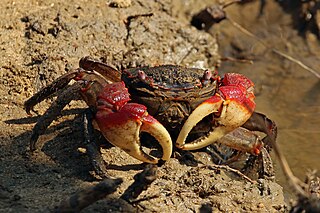
The Sesarmidae are a family of crabs, previously included in the Grapsidae by many authors. Several species, namely in Geosesarma, Metopaulias, and Sesarma, are true terrestrial crabs. They do not need to return to the sea even for breeding.
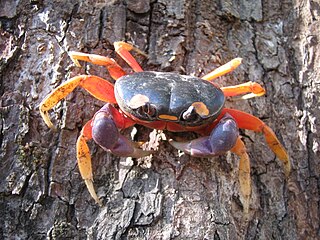
Gecarcinus is the type genus of the land crab family Gecarcinidae. They are found in warmer coastal regions of the Americas, including islands in the Caribbean. Four species from oceanic islands were formerly included in Gecarcinus as the subgenus Johngarthia, but are now treated as a separate genus, Johngarthia. While all members of this genus are largely terrestrial, they have to return to the ocean to breed. They are often colourful, with reddish, orange, purple, yellowish, whitish, or blackish being the dominating hues. This has resulted in some species, notably G. quadratus and G. lateralis, gaining a level of popularity in the pet trade.

Johngarthia is a genus of crabs in the land crab family Gecarcinidae, formerly included in the genus Gecarcinus, and containing six species. The genus bears the name of John S. Garth, a 20th century naturalist who specialized in crabs and other arthropods.

Sesarma is a genus of terrestrial crabs endemic to the Americas.
Tiwaripotamon vietnamicum is a species of crab. Originally described as a species of Geothelphusa, it is now treated as part of the genus Tiwaripotamon, although it has also been suggested as a member of Hainanpotamon. It is only known from a single locality in Cúc Phương National Park, Ninh Bình Province, Vietnam.
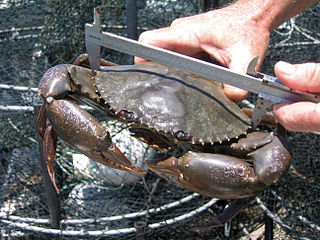
Scylla is a genus of swimming crabs, comprising four species, of which S. serrata is the most widespread. They are found across the Indo-West Pacific. The four species are:
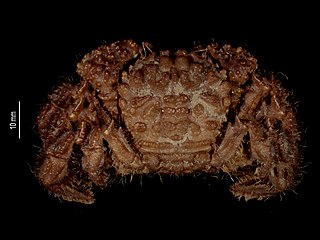
Vultocinus anfractus is a species of crab, the only species in the family Vultocinidae. It has been found around the Philippines, Vanuatu and New Caledonia, and lives on driftwood. Its discovery forced a reappraisal of the relationships within the superfamily Goneplacoidea, and to the recognition of Mathildellidae, Conleyidae and Progeryonidae as separate families.
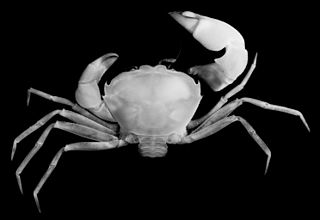
Pseudozioidea is a superfamily of crabs, formerly treated in the Eriphioidea, Carpilioidea, Xanthoidea, Pilumnoidea and Goneplacoidea. A number of fossils from the Eocene onwards are known from the family Pseudoziidae. Eleven genera are recognised in three families:
Villalobosius is a genus of crabs in the family Pseudothelphusidae, containing a single species, Villalobosius lopezformenti. It lives in the northern part of the state of Oaxaca, Mexico, on the Isthmus of Tehuantepec, and is adapted to a troglobitic lifestyle.
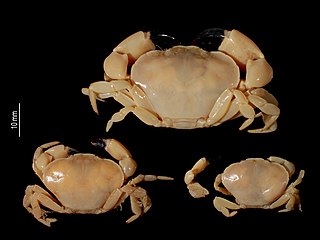
Euryxanthops is a genus of crabs in the family Xanthidae. It was originally established in 1983 by Garth & Kim to contain three species of deep-water crabs from Japan and the Philippines - Euryxanthops dorsiconvexus, Euryxanthops flexidentatus and Euryxanthops orientalis. Since then, several more species of this genus have been identified and described, and Euryxanthops currently contains:
Linnaeoxanthus is a genus of crab, whose only species is Linnaeoxanthus acanthomerus. Linnaeoxanthus is the only genus of the family Linnaeoxanthidae.
Hainanpotamon is a genus of freshwater crabs, containing the following species:

Cancrocaeca xenomorpha is a species of troglobitic (cave-dwelling) freshwater crab from Sulawesi, the only species in the monotypic genus Cancrocaeca. It has been described as the world's "most highly cave-adapted species of crab".

Limnopilos naiyanetri, commonly referred to as the Thai micro crab or pill-box crab, is a freshwater hymenosomatid crab endemic to Thailand. Its presence has only been confirmed in the Tha Chin River. The species was described in 1991 and represents the type species of Limnopilos. The Thai micro crab was first introduced to the aquarium hobby in 2008 when it was imported to Germany by the tropical fish importer Aquarium Glaser GmbH, and has slowly grown in popularity with aquarium hobbyists. It remains a relatively rare species on the market and detailed information on the husbandry of this species is scarce.

Limnopilos is a genus of small hymenosomatid crabs endemic to Southeast Asia. The genus was described by Christina Chuang and Peter Ng in 1991, who identified the new species Limnopilos naiyanetri and distinguished it from the closely related genus Hymenicoides. Its true taxonomic classification was debated for several years, but in 2007 the discovery of a new species of crab in this genus solidified the distinction between Limnopilos and Hymenicoides. Many aspects of the genus Limnopilos are still poorly understood. Their ecology and natural history have not been studied in detail, and their reproductive cycle remains mysterious.
















